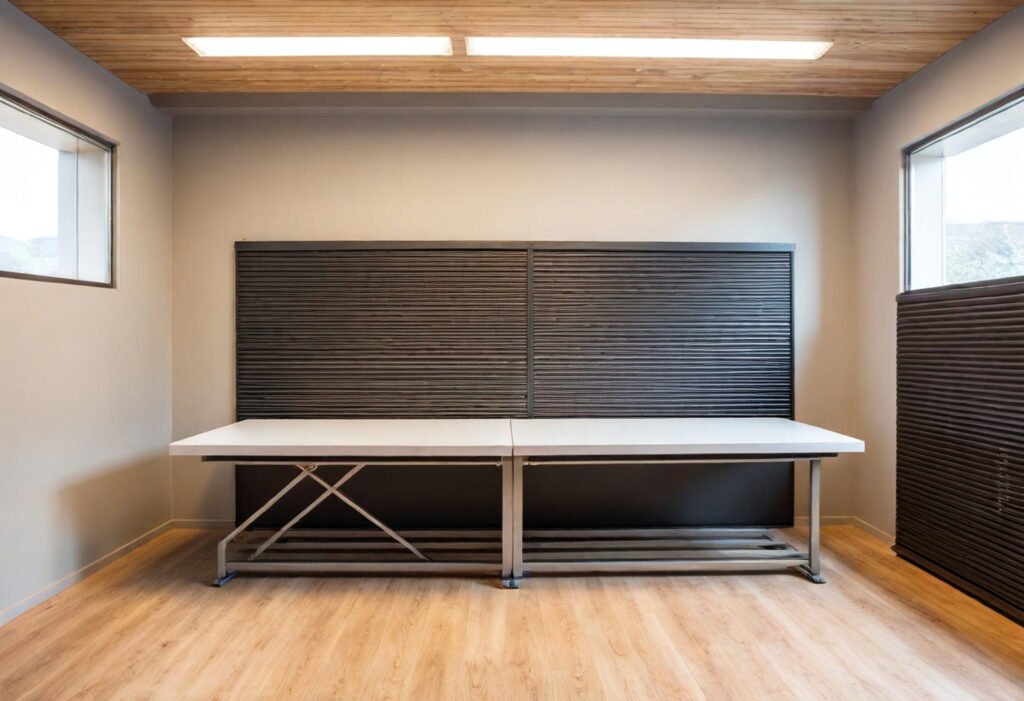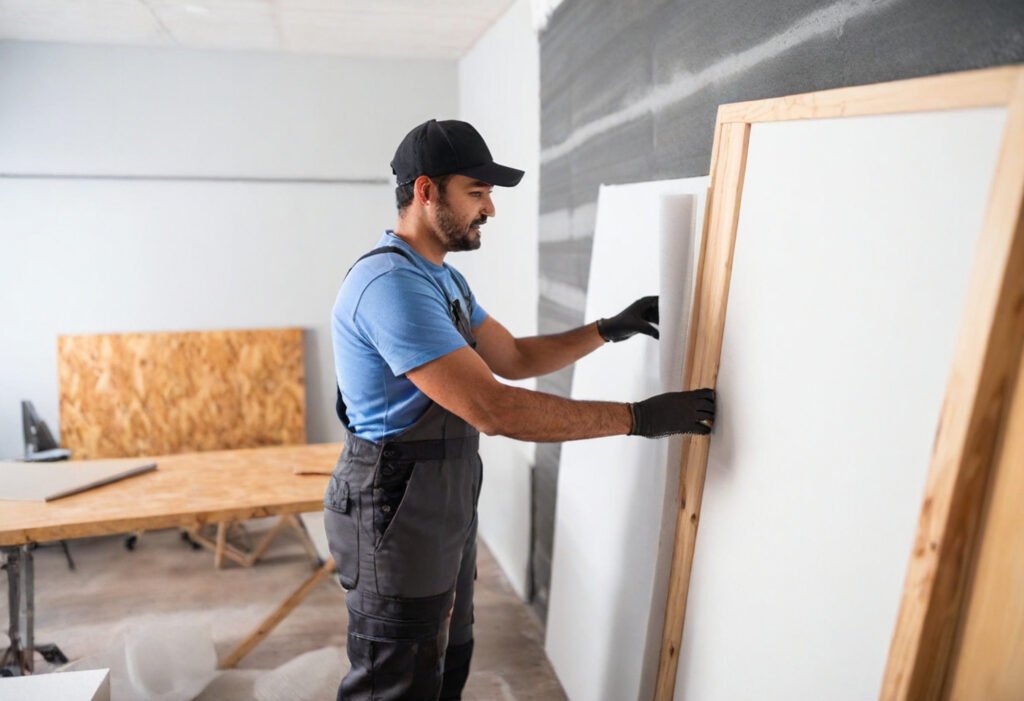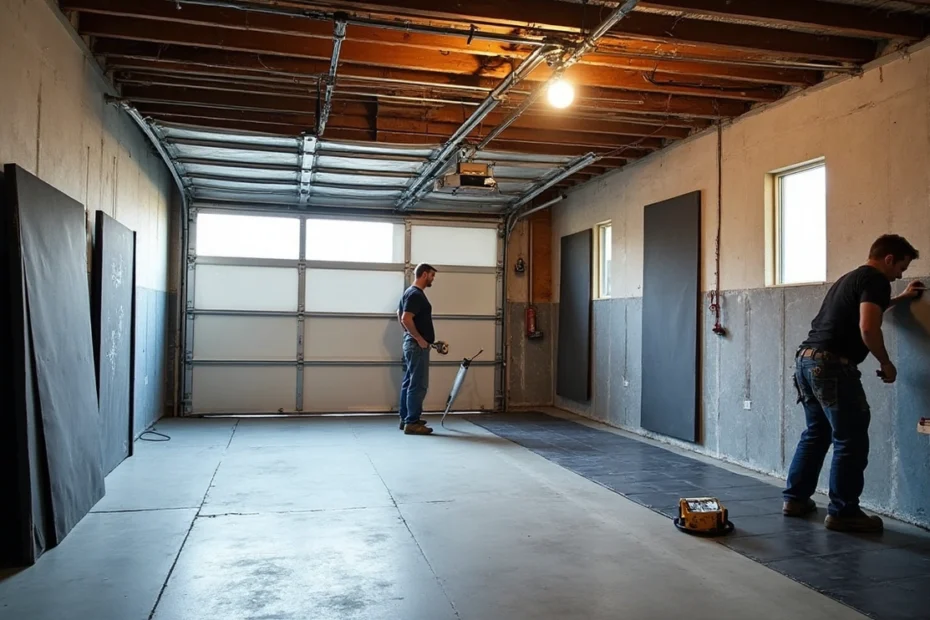Your garage can become a real headache for neighbors if hard surfaces and poor insulation turn your creative space into a noise machine. Band practice, woodworking, or power tool use in your garage sends sound straight through those thin walls and doors.
Garage soundproofing costs range from $1,900 to $14,400 based on your choice of materials and methods. Good soundproofing isn’t just another expense – it’s an investment that can boost your property’s resale value by a lot, especially if you live near highways. A well-soundproofed garage keeps the peace with family and neighbors. It also blocks outside noise and makes your space more useful. Most people don’t know that their garage door leaks the most noise. They also miss small gaps and cracks that can ruin their soundproofing work. This piece shows you proven ways to soundproof your garage with mass-loaded vinyl and acoustic panels. These techniques will revolutionize how you set up studios and workshops.
Soundproofing the Garage Structure
A solid garage structure serves as the foundation of any soundproofing project that works. Most garage walls don’t have proper insulation because they were built to store vehicles rather than creative spaces. The core structure needs attention before you add specialized equipment or acoustic treatments.
Insulating walls with sound-rated materials
Regular thermal insulation won’t block sound well. ROCKWOOL Safe’n’Sound offers specialized acoustic insulation that works much better in interior wall cavities. This stone wool insulation creates a tight friction fit between wood and steel studs. It won’t sag and absorbs sound waves well. The high-density fiber structure makes Safe’n’Sound different from standard insulation. It limits airflow and cuts down noise between spaces.
Using Green Glue and double drywall
Your walls block sound better when you add more mass to them. You can create an effective sound barrier by using double layers of 5/8″ drywall with Green Glue sandwiched between them. Green Glue turns sound energy into tiny amounts of heat through damping. People debate whether it’s worth the cost at around $1.08 per square foot. Many professionals say double drywall with Green Glue makes a real difference in reducing sound.
Installing mass-loaded vinyl (MLV)
Mass Loaded Vinyl packs a lot of density into a thin layer. MLV contains salts, sands, and tiny metal particles that block sound well, even at just 1/8 to 1/4 inch thick. MLV #1 (1/8 inch thick) has a standalone Sound Transmission Class (STC) rating of 26. The thicker MLV #2 (1/4 inch) reaches an STC rating of 32. You can put this flexible material between drywall layers or right on existing walls to boost density and soundproofing.
Treating the ceiling with acoustic insulation
Sound travels easily through the ceiling, usually the largest surface in most garages. Spray foam insulation or acoustic ceiling panels work well for ceiling treatment. Stone wool slabs can be attached to ceilings mechanically. Their sound-absorbing properties reduce both echo and noise levels. Good ceiling insulation helps save energy by blocking heat transfer, along with sound.
Sealing Entry Points and Openings

Your garage soundproofing work won’t matter much if entry points and openings remain unsealed, even with well-insulated walls and ceilings. Sound finds its way through any air passage, which makes doors and windows crucial areas to focus on during your garage soundproofing project.
Weatherstripping garage doors and side doors
Weatherstripping acts as the primary defense against sound leakage. Quality weatherstripping with good STC ratings should replace any worn or damaged strips around door frames. You need to get into the perimeter of your garage door and side entry doors to spot gaps that let sound escape. A tiny 1% opening around a door lets up to 50% of sound energy pass through, which nullifies your other soundproofing work.
The best way to seal these gaps involves applying exterior-grade caulk around stationary parts and installing new weatherstripping where doors meet frames. Door seal strips made from durable materials like aluminum, vinyl, and rubber create an airtight barrier and resist mildew.
Using acoustic door seal kits
Acoustic door seal kits come with jamb seals, threshold seals, and automatic door bottoms that create an airtight perimeter. These specialized kits boost the Sound Transmission Class (STC) rating of existing doors. Quality door seal kits add up to 20 STC points to a solid-core door [link_2], which helps reach an STC rating of 46.
Neoprene seals in most kits compress as the door closes to block sound transmission effectively. The automatic door bottom uses springs that drop a seal onto the threshold whenever someone closes the door. You’ll achieve the best results by combining acoustic door seals with sound barrier materials on the door surface.
Soundproofing windows with inserts or curtains
Window inserts reduce sound substantially without needing window replacement. These custom-built acrylic panels fit inside window frames and cut sound transmission by up to 70-80%. Climate Seal Acoustic Series inserts achieve STC ratings up to 49, matching complete window replacements at a much lower cost.
Specialized soundproof curtains provide a flexible alternative. Quality acoustic curtains reduce external noise through glazed windows by up to 15 decibels. These curtains also offer thermal insulation and UV protection, which helps lower heating and cooling costs.
Studio and Workshop Specific Soundproofing
Your garage soundproofing needs specialized treatments based on your creative activities. The right solutions can tackle specific acoustic challenges, whether you make music or work with power tools.
Using bass traps and acoustic panels for studios
Low-frequency control is crucial for garage music studios. Bass traps are specifically designed to absorb low-frequency sounds that build up in corners and create unwanted boominess. Bass traps work better than standard acoustic panels because they’re thicker (6″-8″) and denser. You’ll get better absorption down to 40Hz when you install them with an air gap.
Bass traps work best in these spots:
- Room corners (where bass energy accumulates)
- Wall-ceiling junctions
- Behind speakers
- Back walls
Standard acoustic panels (1″-4″ thick) work alongside bass traps to handle mid to high frequencies. You should place these panels at ear level on side walls, ceilings, and main reflection points. This setup reduces echo and makes the sound clearer.
Vibration isolation pads for power tools
Your power tools create strong vibrations that move through floors and walls. Vibration isolation pads can solve this problem by absorbing shock and stopping it from spreading to nearby structures. These pads use tough materials like neoprene, rubber, and cork. Their non-slip surfaces keep your machines steady and quiet.
Rubber flooring for gym or workshop use
Rubber floors are great at dampening sound from high-impact activities. The best acoustic gym flooring can cut impact sound by up to 38 decibels. Pick your thickness based on what you do – 3/8″ works for basic needs, but you’ll want 1″ or more for dropping heavy weights. Many rubber floors come with studded bottoms that help reduce sound transfer and vibrations even more.
Curtains or enclosures for noisy equipment
Industrial soundproof curtains give you flexible ways to contain noise from specific machines. These curtains combine quilted fiberglass batting with mass-loaded vinyl and can achieve sound transmission loss ratings (STC) up to 33. Track systems let you mount these curtains easily. You’ll get good access while creating sound barriers around your compressors, generators, or other loud workshop equipment.
Cost and Material Considerations

Your budget plays a crucial role in planning garage soundproofing projects. The available funds determine which materials and methods you can use.
DIY vs professional installation
You can cut costs a lot through DIY soundproofing projects. Simple jobs like hanging acoustic panels or installing weatherstripping help you save $250 to $500 in labor costs. Notwithstanding that, you need professional expertise for complex projects with structural changes, electrical work, or specialized installations. Professional soundproofing contractors ask $8 to $13 per square foot. General handymen charge $50 to $80 per hour but might lack specialized knowledge.
Time requirements vary quite a bit. Hanging soundproof curtains takes less than an hour. Installing acoustic tiles might need a full week. DIY approaches save money upfront, but poor installation can get pricey later. Professional installation delivers better acoustic results, especially for studios or workshops that need substantial noise reduction.
Budget-friendly materials that work
Several affordable options deliver good results to soundproof your garage:
- Heavy-duty moving blankets or acoustic blankets work well as wall coverings
- Weatherstripping and door seal kits close gaps effectively
- EVA foam mats help with floor sound dampening
- Thick carpets or rubber mats prove valuable for gym or workshop use
Standard thermal insulation might seem cheaper than acoustic insulation, but it barely reduces sound and needs replacement sooner. Regular caulk instead of acoustic caulk shrinks and cracks, which ruins your soundproofing work.
How much does it cost to soundproof a garage?
Garage soundproofing costs vary widely based on size, materials, and desired noise reduction. Basic DIY solutions cost under $500. Complete professional soundproofing ranges from $2,800 to $17,400 for typical garage sizes (280-580 square feet). Professional soundproofing in existing structures averages $105 per square foot.
Materials ($200-$5,100), labor ($800-$3,900), treated surfaces, removal of existing materials, and structural elements like walls ($25-$64 per linear foot) affect the final cost. New construction soundproofing costs about $15 per square foot. Modernizing existing spaces runs around $30 per square foot.
Conclusion
Good garage soundproofing can turn your basic garage into a functional studio or workshop that keeps peace with the neighbors. We’ve looked at several proven ways to strike this balance. Sound control starts with the structure’s foundation, especially when you have specialized acoustic insulation and mass-loaded vinyl. You’ll need to seal all entry points to stop sound from leaking and undoing your hard work.
Music spaces work great with studio-specific solutions like bass traps, while workshops with power tools need vibration isolation pads. A complete soundproofing setup needs a big investment, but you can find budget-friendly options if your resources are limited. Don’t see soundproofing as just another expense – call it an investment that boosts your creative experience and property’s value.
Your garage soundproofing project’s success ended up depending on what you need and what you can spend. DIY methods will save money, but you just need time and careful research. Professional installation gives reliable results but costs more. Whatever approach you choose, the right materials and careful installation make the difference between poor results and proper sound isolation.
Your garage’s potential goes way beyond storage. Smart soundproofing creates a space where creativity thrives without bothering anyone else. Band practice, woodworking, or any noisy hobby can happen freely at any time. This change not only helps your creative work but also promotes better relationships with family and neighbors who don’t have to put up with unwanted noise anymore.
